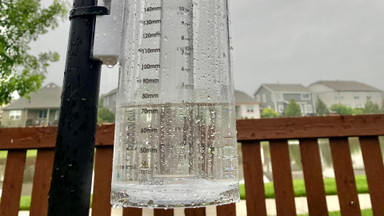Posted by Climalytic Instruments, LLC on 6th Apr 2024
TROPO Tips and Tricks for Spring and Summer
Using the TROPO in the Spring and Summer
The TROPO precipitation gauge is an all-weather precipitation gauge, and while a previous article addressed tips for using the gauge during winter, this article features tips for summer or warm climates. We’ve made a top 10 tips and tricks article before, but now we have some extra tips to share.
1. Measuring rain by weight
Although weighing precipitation is the preferred way to measure the liquid equivalent of snow, weighing rain water tends to be a lesser used technique. With that said, weighing liquid-only precipitation can provide highly accurate measurements, while also being fast, easy and rather fun. First, use a scale to determine the weight of the dry, empty gauge, including the funnel/cap, and handle if you plan to use that during your observation. Write the weight on the bottom of the tube with a Sharpie® for future reference, and specify what parts of the gauge are included in this dry weight. When it’s time to measure the rainfall, weigh the entire gauge and subtract the dry weight to determine the weight of just the precipitation. Take the weight in grams and divide it by 206 g (or weight in ounces divided by 7.27 oz). The first time you do this, make a traditional volume measurement using the graduations on the gauge, then measure the rain by weight. Do some math to convert the weight of the rain (in grams) into depth (in inches) when using a 4-inch diameter cylinder. In my experience, when using the TROPO at least, the measurements have always been exactly the same!
When more than 1 inch has collected in the gauge, measuring by weight can actually save you some time, as you will not have to decant the rain water from the outer tube into the inner tube. Every time I have done this, the converted weight and volume measurements are exactly the same — try it!
2. Rounding up
The design of the TROPO makes it possible to discern rainfall amounts to a higher resolution than .01 inches, but we always recommend rounding up to the nearest hundredth of an inch (or 2 mm). In other words, if the gauge reading shows the waterline (meniscus) between the .01 and .02 markings, record it as .02 inches. The excess rain clinging to the sides of the inner tube and funnel is likely to amount to around .005 inches.
3. Gauge sitting height and location
There is not an official requirement for how far up the TROPO gauge should extend above the post, fence or pole it’s attached to, however, to limit splashing from the post or fence into the gauge, or wind under/over-catch impacts, we recommend the top of the TROPO be positioned as far above the post or fence as possible. It is strongly recommended that the wooden post be beveled at the top to limit any splashing into the gauge. Additionally, for optimal sitting of the gauge, install the gauge a few feet off the ground in an open area, and as far away from any objects, trees, or buildings as possible.
4. Measuring hail
We have purposely designed the TROPO with higher side walls around the funnel for better catchment of hail and graupel, but if you expect hail, and it’s safe to go outside, removing the funnel cap before the storm hits will make for a much more accurate precipitation (liquid equivalent of hail) reading. If you live in hail country, it’s tempting to be proactive and just leave the funnel cap off all the time, but then the negative effects of evaporation on your measurements will be much greater.

